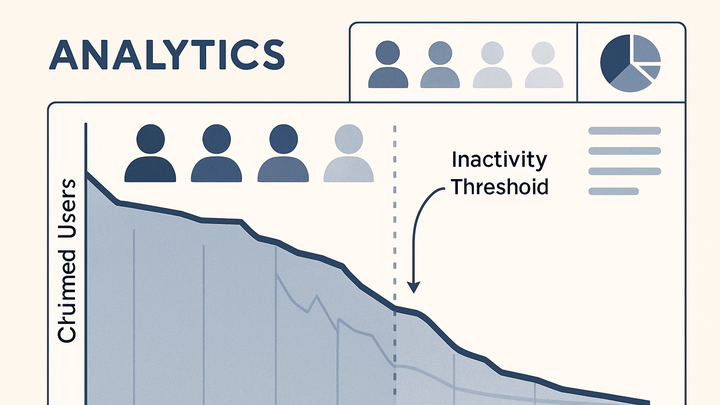Published on 2025-06-22T06:56:49Z
What Is a Churned User? Analytics Definition & Examples
In analytics, a churned user is someone who has stopped engaging with your product or service after a specified period of inactivity. Understanding churned users is vital for measuring retention, forecasting revenue, and improving customer lifetime value. Google Analytics 4 (GA4) lets you define inactivity windows—such as 30 days—to automatically segment churned users in its retention reports. PlainSignal, a cookie-free simple analytics tool, enables you to set custom churn thresholds and track user sessions without cookies. By identifying churned users, teams can uncover friction points, optimize features, and deploy re-engagement campaigns. Tracking and analyzing churn empowers organizations to reduce user loss and strengthen long-term growth.
Churned user
A churned user is someone who stops engaging after a defined inactivity window, used to measure retention and drive re-engagement.
Definition of a Churned User
This section clarifies the core concept of a churned user, the significance of defining inactivity thresholds, and how various platforms interpret churn.
-
Standard definition
A churned user is anyone who has not used or engaged with a product or service within a predefined time window, signaling they may have abandoned it.
-
Platform variations
Analytics tools differ in their churn criteria: GA4 often uses fixed 30-day inactivity by default, while PlainSignal allows you to set custom thresholds based on your business model.
Importance of Tracking Churned Users
Understanding who churns and why is essential for diagnosing product issues, measuring business health, and prioritizing retention efforts.
-
Business impact
High churn rates directly affect recurring revenue and growth projections, making it critical to monitor and minimize user drop-off.
-
Product insights
Churn analysis reveals feature gaps, onboarding hurdles, and usability pain points that drive users away.
How to Track Churned Users
This section outlines methods for measuring churn in GA4 and PlainSignal, along with best practices to ensure consistent and accurate tracking.
-
Tracking churn in GA4
In Google Analytics 4, use the built-in User Retention report and set the ‘Return Period’ parameter to your chosen inactivity window (for example, 30 days) to segment churned users.
-
Example GA4 retention report
Navigate to ‘Lifecycle > Retention’, adjust the ‘Return Period’ to define churn, and export the segment of users who failed to return within that window.
-
-
Tracking churn in PlainSignal
PlainSignal’s cookie-free analytics lets you specify a churn threshold in days; it then automatically categorizes users who exceed that inactivity period.
-
Integration code snippet
html <link rel="preconnect" href="//eu.plainsignal.com/" crossorigin /> <script defer data-do="yourwebsitedomain.com" data-id="0GQV1xmtzQQ" data-api="//eu.plainsignal.com" src="//cdn.plainsignal.com/plainsignal-min.js"></script>Replace thedata-dovalue with your domain anddata-idwith your project ID.
-
-
Best practices
Align your inactivity window with user behavior patterns, maintain consistent definitions across tools, and combine quantitative churn metrics with qualitative feedback for deeper insights.
Strategies to Reduce User Churn
Once you’ve identified churned users, deploy targeted tactics to keep them engaged, improve their experience, and encourage retention.
-
Onboarding optimization
Simplify initial setup with step-by-step guides, interactive walkthroughs, and contextual tooltips that demonstrate core value quickly.
-
Personalized engagement
Segment users by behavior and send tailored emails, in-app notifications, or content recommendations that resonate with their preferences.
-
Feedback loops
Deploy in-app surveys and feedback widgets to identify friction points early and act before users decide to churn.
-
Re-engagement campaigns
Use email, push notifications, or remarketing ads with special offers, feature highlights, or product updates to win back inactive users.
Example Scenarios and Use Cases
Explore real-world examples of how companies leverage churn data to inform retention strategies and drive growth.
-
Saas subscription renewal
A B2B software provider identifies at-risk customers via churn segments and triggers personalized renewal offers to increase retention.
-
E-commerce re-engagement
An online retailer tracks users inactive for 45 days and sends targeted discount codes to encourage repeat purchases.
-
Mobile app retargeting
A mobile gaming company pushes notifications about new levels and rewards to users who haven’t played in the past week, reducing churn.
